THE HISTORY OF ANI: RECENT HISTORY - 90 YEARS OF DESTRUCTION
After The First World War
From 1915 until the early 1920s a series of massacres and deportations resulted in the destruction of almost the entire Armenian population within Turkish controlled territory. An estimated 1½ million Armenians perished at the hands of the Turkish and Kurdish perpetrators of this genocide.To this day the Turkish State disputes that anything which could be classified as "genocide" actually took place. An important part of this denial has taken the form of minimising or removing evidence of the long Armenian presence in what is now eastern Turkey. If the victims never existed then how could they be killed, and if (a few) were killed then why should it matter if they, as a people, were of no cultural significance? With this aim, official Turkish history has been rewritten to eliminate the importance of Armenia and invent or exaggerate Turkish influences, population statistics have been falsified, and most place names of Armenian origin have been changed to Turkish ones. None of this encourages the preservation of Armenian buildings, the most obvious reminder and legacy of a past that Turkey wishes to entirely eliminate.
Cultural GenocideAfter the killing or removal by other means of a region's original population, the destruction of that population's cultural monuments invariably follows. The most recent example of this process occured in Kossovo."A people which is cut off from its own past is far less free to choose and to act as a people than one which has been able to situate itself in history. This is why - and this is the only reason why - the entire art of the past has now become a political issue"
- John Berger, "Ways of Seeing"
In the years following the Armenian Genocide hundreds of Armenian churches in Turkey were deliberately destroyed because of their Armenian origin, a policy which continued at least into the 1970s. Hundreds, probably thousands, more have been allowed to fall into ruin, or to be plundered for building material, or to be demolished for redevelopment. The majority of these buildings had never been properly studied or even photographed. Since the 1930s there has been a conspiracy of silence amongst western archaeologists and art historians regarding Armenian sites in Turkey: they seem to turn unaccountably blind, deaf, and dumb whenever the word "Armenia" is mentioned. Even Armenian academics have participated in the cover-up. ¹ Today within Turkey, surviving Armenian buildings (especially those important for tourism) are often presented as being of Turkish or Byzantine origin, or they are presented as isolated examples that are unconnected to any larger Armenian culture, or the Armenian identities of the builders are disguised by calling them "Bagratid" or "Artzrouni" (the names of medieval Armenian princely families). What Happened at Ani?In May 1921 Riza Nur, a member of the Turkish Assembly, wrote to general Kazim Karabekir, commander of the Eastern Front, ordering that"the relics and the traces of the monuments of Ani be wiped off the face of the earth". He added "You will be rendering a great service to Turkey when you accomplish this goal" ². Karabekir recorded in his memoirs that he replied dismissively to Nur, saying that the Ani ruins were vast, like the walls of Istanbul, and that even if they were destroyed - which in itself would be a very difficult task - they would still remain as ruins on the same spot. He also warned that the destruction of Ani would be likely to stir up sentiment amongst the Armenian religious community.Some destruction did take place. Most of what seems to have been destroyed were the visible results of Nikolai Marr's excavations, including most of his repairs and restorations. Certain structures that would have been seen as having symbolic importance to Armenians may also have been destroyed at this time (such as the tomb of King Ashot at Horomos, and the khatchkar monument of Catholicos Barsegh).Many Armenian monuments in the vicinity of Ani have been destroyed since 1920. The dates of their destruction are not exactly known. See the pages on the Khtzkonk and Bagnayr monasteries, the Tekor basilica, and Magazberd for examples.Even though the 1921 order for the total demolition of Ani was not carried out, the history of Ani since the 1920s has been one of continuous and increasing destruction. The reasons for this can be placed into several categories: Damage Due To Natural EventsAn earthquake in 1935 is said to have destroyed most of the Oğuzlu church. Half of the church of the Redeemer collapsed during a storm in 1957. The Russian excavators had repaired this building. The Georgian church had collapsed by the 1960s, this building had also been repaired by the Russians. The church of the Shepherd and the citadel church known as the "mausoleum of the child princes" were destroyed in another earthquake in 1966. The southern half of the"palace church" probably collapsed during the same earthquake. The earthquake that devastated northern Armenia on the 7th December 1988 was also felt at Ani. There was damage to the city walls, to the narthex of the Tigran Honents church, and, in particular, to the north-west corner of thecathedral, which collapsed.The surviving half of the church of the Redeemer has now reached a state of imminent collapse, as have the southwest corner of the Cathedral, the surviving parts of the narthex of the church of Tigran Honents, and the hall of the church of the Apostles. | 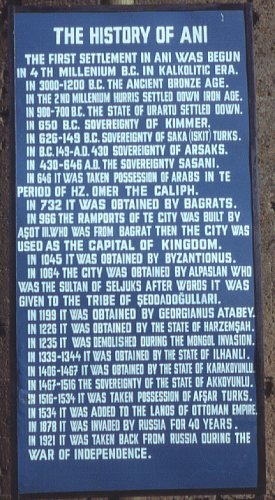 1. This information for tourists is placed at the entrance to Ani. The "history" that it tells is mostly fantasy, and Armenia is not even mentioned once! 1. This information for tourists is placed at the entrance to Ani. The "history" that it tells is mostly fantasy, and Armenia is not even mentioned once! 2. Khtzkonk monastery, near Ani, a pre-1920 photo 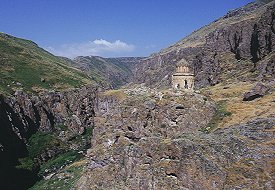 3. The condition of Khtzkonk monastery today. 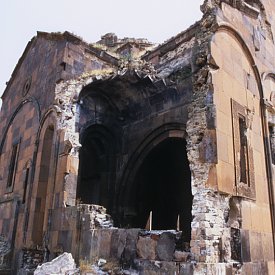 4. Damage to the cathedral by the 1988 earthquake 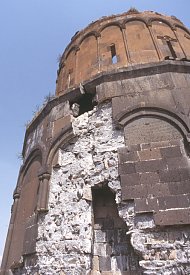 5. This crack has recently appeared in the surviving half of the church of the Redeemer |
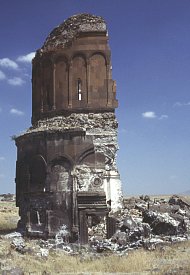 6. Half of the church of the Redeemer collapsed in 1955 during a storm | 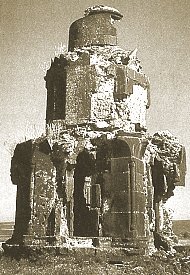 7. The church of the Shepherd - destroyed in the 1966 earthquake | 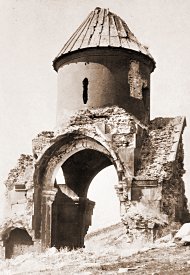 8. One of the citadel churches - destroyed in the 1966 earthquake |
Damage Caused by Vandalism
Digging amongst the ruins by local villagers hunting for treasure used to be common. Fortunately, the damage caused by this activity was mostly small in scale - an exception being the 1998 breaking open of the graves in the burial chapels next to the church of Saint Gregory of the Abughamir's.Visitors to Ani, both Turkish and foreign, seem to think that there is nothing wrong in writing their names onto the walls of the churches. The church of Tigran Honents, because of its frescoes, has been particularly susceptible to this sort of damage. Since the removal of travel restrictions to Ani in 2004, many Turkish visitors now come to Ani to picnic amongst the ruins. In total ignorance about how to behave at an archaeological site, they start fires, leave lots of rubbish behind, and use the churches as urinals. Visitors from Armenia are almost as ignorant - as proof, one need only note the number of empty bottles of "Noy" mineral water from Armenia that now litter the site.
Officially Sanctioned DamageBecause the cathedral is the most prominent Armenian building in Ani it was the most likely candidate to suffer from state censorship. The interior walls of the cathedral are covered with crudely applied daubs of modern white paint. This paint has been put there to hide Armenian inscriptions. In other locations the paint has been carefully applied in blocks and has been chosen to blend in with the colour of the stone. The application of this paint occured not later than 1983. Probably, many of the inscriptions dated from after the fall of Ani and they have been hidden to remove the visible evidence of a continuing Armenian population in the Kars region, especially during the Russian period.When the amount of tourist graffiti covering the frescoes inside the Tigran Honents church became too great, the supposed custodians of Ani simply covered over the damaged parts with white paint. The frescoes on the northern wall of this church were particularly badly damaged by graffiti (including a large CND symbol carved into the plaster). To 'tidy' this section, the entire lower registry of paintings was chipped off! This destruction occurred during the early 1990s. It must have taken a considerable amount of time and effort to accomplish, and could not have been done without the use of scaffolding or ladders.The Stone Quarry Opposite AniIn 1999 a quarry was opened on the Armenian side of the border to extract stone for a new cathedral that was being built in Yerevan to mark the 1700th anniversary of Armenia's conversion to Christianity. It was decided to use "Ani stone" as a gimmick to attract the rich foreign donors needed to pay for its construction. The quarry was not closed when the cathedral was finished, and it now grows bigger in area as each year passes.In addition to the obvious environmental damage to the landscape, and the noise pollution from the constant sound of heavy machinery, explosions within this quarry caused the fragile buildings at Ani to literally shake. Click here to read a page about the quarry and the issues related to it. | 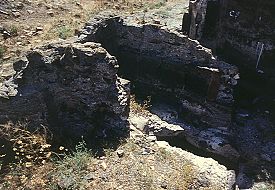 9. Graves beside the church of Saint Gregory of the Abughamir's - desecrated by treasure hunters 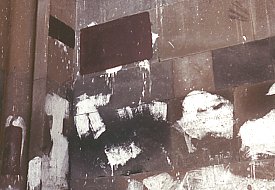 10. Armenian inscriptions hidden by modern paint 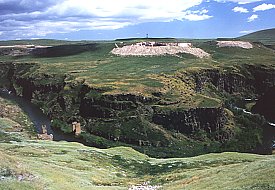 11. The stone quarry located directly opposite Ani |
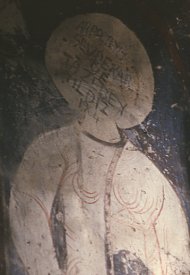 12. Got vandalism on your frescoes? | 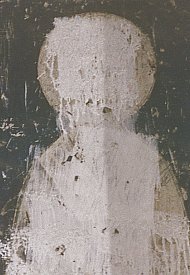 13. Then paint over it with whitewash | 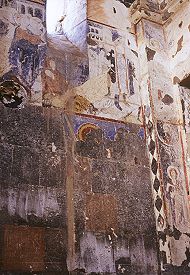 14. Or just chip the damaged bits off |
The Damage Caused by the
|


No comments:
Post a Comment